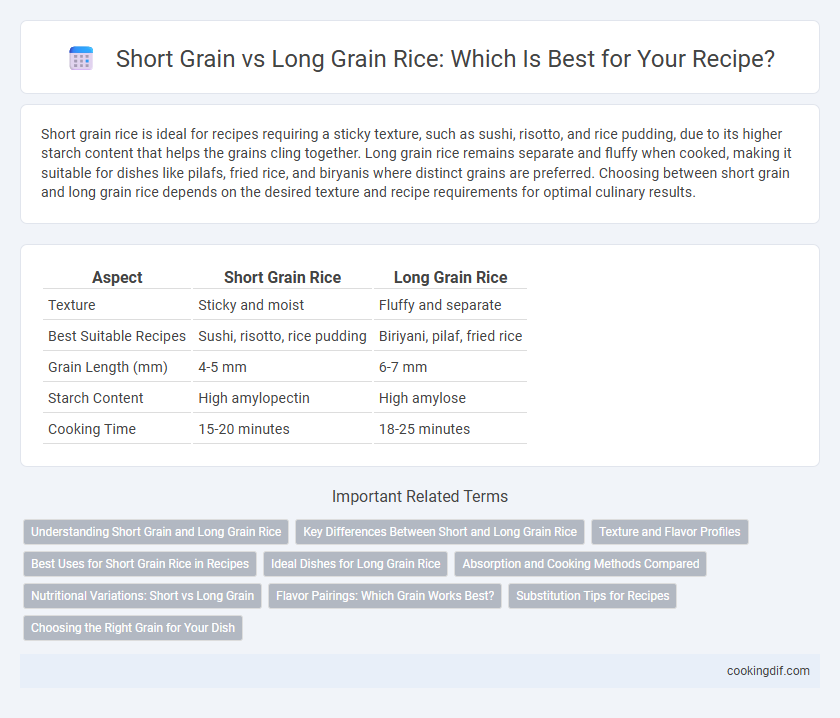Short grain rice is ideal for recipes requiring a sticky texture, such as sushi, risotto, and rice pudding, due to its higher starch content that helps the grains cling together. Long grain rice remains separate and fluffy when cooked, making it suitable for dishes like pilafs, fried rice, and biryanis where distinct grains are preferred. Choosing between short grain and long grain rice depends on the desired texture and recipe requirements for optimal culinary results.
Table of Comparison
| Aspect | Short Grain Rice | Long Grain Rice |
|---|---|---|
| Texture | Sticky and moist | Fluffy and separate |
| Best Suitable Recipes | Sushi, risotto, rice pudding | Biriyani, pilaf, fried rice |
| Grain Length (mm) | 4-5 mm | 6-7 mm |
| Starch Content | High amylopectin | High amylose |
| Cooking Time | 15-20 minutes | 18-25 minutes |
Understanding Short Grain and Long Grain Rice
Short grain rice is plump and sticky due to its high amylopectin content, making it ideal for dishes like sushi, risotto, and rice pudding where a creamy or clumped texture is desired. Long grain rice has a higher amylose content, resulting in fluffy, separate grains perfect for pilafs, fried rice, and biryanis where distinct grain texture is essential. Selecting the right rice grain length enhances recipe outcomes by matching starch properties to cooking methods and dish requirements.
Key Differences Between Short and Long Grain Rice
Short grain rice is plump and sticky when cooked, making it ideal for dishes like sushi, risotto, and rice pudding where a creamy texture is desired. Long grain rice remains separate and fluffy, perfect for pilafs, fried rice, and as a side dish where individual grains are preferred. The primary difference lies in the starch composition: short grain rice contains more amylopectin, leading to its stickiness, while long grain rice has higher amylose content, resulting in a drier, fluffier texture.
Texture and Flavor Profiles
Short grain rice is typically stickier and creamier, making it ideal for dishes like risotto, sushi, and rice pudding where a cohesive texture enhances the eating experience. Long grain rice remains fluffy and separate when cooked, offering a light, dry texture that works well for pilafs, biryanis, and stir-fries, complementing bold, spicy flavors without clumping. Texture and flavor profile differences between short and long grain rice determine their suitability for diverse culinary applications, influencing moisture retention and mouthfeel.
Best Uses for Short Grain Rice in Recipes
Short grain rice is ideal for recipes requiring a sticky and creamy texture, such as sushi, risottos, and rice puddings. Its higher starch content ensures grains cling together, enhancing dishes that need moisture retention and a chewy bite. Short grain rice also works well in Asian cuisine, including dishes like bibimbap and mochi, where cohesiveness and flavor absorption are key.
Ideal Dishes for Long Grain Rice
Long grain rice is ideal for recipes requiring fluffy, separate grains, such as pilafs, fried rice, and jasmine or basmati-based dishes. Its lower starch content and firm texture make it perfect for salads, stir-fries, and grilled meat accompaniments where distinct grain separation enhances the dish. This variety's versatility in absorbing flavors while maintaining structure suits Mediterranean, Middle Eastern, and Asian cuisines.
Absorption and Cooking Methods Compared
Short grain rice has higher starch content, resulting in greater water absorption and a stickier texture, making it ideal for dishes like sushi and risotto that require creaminess and cohesion. Long grain rice absorbs less water, cooks to a fluffier, drier texture, and is best suited for pilafs, biryanis, and side dishes where separate grains are preferred. Cooking methods for short grain often involve simmering with precise water ratios and minimal stirring, while long grain benefits from boiling or steaming techniques that preserve individual grain integrity.
Nutritional Variations: Short vs Long Grain
Short grain rice typically contains higher amylopectin, giving it a sticky texture ideal for sushi and risottos, while long grain rice has a higher amylose content, resulting in fluffy, separate grains perfect for pilafs and biryanis. Nutritionally, short grain rice often has a slightly higher carbohydrate content and lower fiber compared to long grain varieties, which may provide better digestion and slower glucose release. Both types offer essential nutrients like manganese, selenium, and B vitamins, but the choice depends on the desired texture and glycemic impact in recipes.
Flavor Pairings: Which Grain Works Best?
Short grain rice, known for its sticky texture and slightly sweet flavor, pairs exceptionally well with rich, creamy dishes like risottos and sushi, where its ability to absorb flavors enhances the overall taste experience. Long grain rice, characterized by its fluffy, separate grains and mild flavor, complements dishes with bold spices and sauces, such as biryanis and pilafs, allowing the seasoning to stand out without overpowering the rice itself. Choosing between short and long grain rice depends on the flavor profile of the recipe; short grain suits savory, umami-rich pairings, while long grain excels with aromatic and spicy combinations.
Substitution Tips for Recipes
Short grain rice tends to be stickier and creamier, making it ideal for dishes like sushi, risotto, and rice pudding, while long grain rice is fluffier and separate, perfect for pilafs, biryanis, and stir-fries. When substituting short grain for long grain in recipes, rinse thoroughly to reduce stickiness and cook with slightly less water to maintain texture. Conversely, if using long grain instead of short grain, increase water slightly and expect a less cohesive texture, which may affect dishes requiring creaminess or compact grains.
Choosing the Right Grain for Your Dish
Short grain rice is ideal for dishes requiring a sticky, creamy texture such as risottos, sushi, and rice puddings, due to its higher amylopectin content. Long grain rice remains separate and fluffy when cooked, making it perfect for pilafs, fried rice, and biryanis where distinct grains are preferred. Selecting the right rice grain directly affects dish texture and flavor absorption, enhancing the overall culinary experience.
Short Grain vs Long Grain for recipe suitability Infographic

 cookingdif.com
cookingdif.com